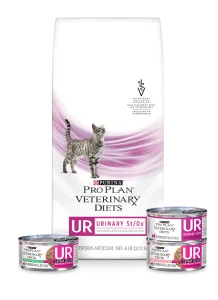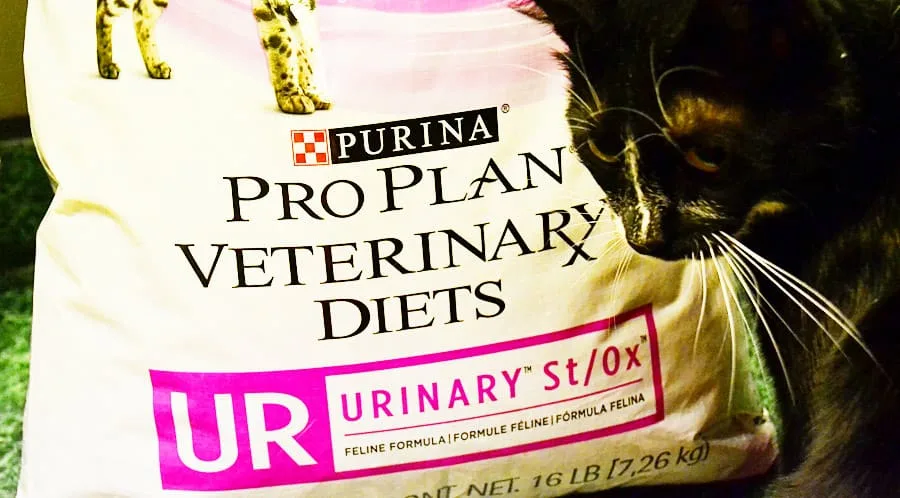
This post is sponsored by Purina. I am being compensated for helping spread the word about Purina Pro Plan Veterinary Diets UR Urinary St/Ox Feline Formula, but CatTipper only shares information we feel is relevant to our readers.
Since our very first cat, Cheeto, we’ve been acutely aware of Feline Lower Urinary Tract Disease, or FLUTD. This group of diseases impacts both the bladder and the urethra in cats and due to it what first seem like simple litterbox issues can turn into a life-threatening condition.
After Cheeto, our Felix also battled with FLUTD and was hospitalized three times during his lifetime to unblock the urethra. And this past summer, our cat Lucky formed stones and underwent surgery.

Upon Lucky’s diagnosis, our vet prescribed Purina Pro Plan Veterinary Diets UR Urinary St/Ox Feline Formula.
Available in both dry and new wet foods, these formulas are designed to meet the special dietary needs of cats that are predisposed to lower urinary tract conditions.
Lucky really loves the food; when he was transferred to a specialty hospital before his surgery, they didn’t stock Purina Pro Plan Veterinary Diets–and Lucky wouldn’t eat.
The hospital wound up calling me to see if I could bring him some of the UR food to encourage him to eat. It worked like a charm. Lucky ate, built up his strength, had his surgery to remove the bladder stones, and came back home by the end of that week.
Today Lucky continues on Purina’s UR food and just loves it! (Shh…he doesn’t know that it’s good for him…he just thinks it’s yummy!)

Learning More about FLUTD
We’ve got some helpful tips and facts from Purina Pro Plan Veterinary Diets UR Urinary St/Ox Feline Formulas to share about FLUTD. You’ll find their advice below; I’ve commented in italics with our own experiences through the years with our cats who have wrestled with FLUTD.
Age, gender and physical activity can help indicate whether or not your cat is at a higher risk for developing FLUTD.
- Gender: Both male and female cats can experience urinary tract disorders, but since male cats have longer and narrower urethras, their urinary tracts are more likely to be obstructed by crystals and mucous. Our experience really falls right along these lines. Lucky is a male; our previous cats Cheeto and Felix were both male as well. We’ve had numerous female cats through the years but the males have always been the ones with FLUTDs.
- Breed: Urinary problems are more common in certain breeds, such as Persians, where there is a lower incidence in Siamese. I don’t have any experience here since our cats aren’t purebreds. Cheeto, however, was a Maine Coon mix. Lucky is a tuxedo cat, as was Felix.
- Age: Young adult cats between the ages of 2 and 6 years are more likely to have lower urinary tract disorders, but cats of any age are susceptible. Lucky was just 18 months old when his issues arose but Cheeto and Felix were both about five years old the first time they experienced urinary tract problems.
- Activity Level: indoor cats seem to be more susceptible to lower urinary tract disorders. This may be because confinement reduces physical activities, which in turn may reduce the amount of water consumed and frequency of urination, allowing crystals to form in the urine. All our cats are indoor-only cats. We do a LOT of wand play with Lucky, partly because he just loves it (and demands it!) but also to help keep him more active and hopefully to prevent future problems.
- Diet: high levels of ash and magnesium in the diet were once throught to cause crystals. However, more recent work indicates that urine pH and concentration are more important factors in the development of FLUTD. Increasing water intake is highly recommended to help reduce the risk of FLUTD. Our cats have both a fountain and still water so they have various drinking options to hopefully encourage more water consumption. Our previous cats didn’t have a fountain but I often used different types of bowls and placed them at new spots around the house to encourage more water consumption (and that worked!)
How to Recognize the Symptoms
How will you know if your cat is experiencing FLUTD? By being aware of the signs…and catching those signs as soon as possible so you can get your cat treatment before additional problems develop.
Here’s a list of commonly seen changes in your cat’s appearance or behavior if he or she is experiencing FLUTD:
- Makes frequent trips to the litterbox (this was Lucky’s first sign)
- Cries when urinating
- Urinates outside the litter box (this came later with Lucky when he began walking up to me and urinating directly in front of me…he was definitely saying WATCH ME!)
- Licks genital area excessively
- Strains to urinate, with little success (we’ve seen this through the years and always noticed the length of time the cats were staying in the litterbox. I remember anytime Cheeto began staying in the litterbox…and staying…we knew it was time for a quick checkup.)
- Displays signs of anxiety, such as pacing or hiding
Saving Money on Prescription Food
OK, there’s no other way to say it: veterinary foods are not inexpensive. They are, however, FAR, FAR less expensive than the numerous vet visits, emergency vet visits, and surgery bills that you could face if your cat becomes blocked.
You’re going to be buying food anyway so the difference in cost isn’t that much compared to the benefits and peace of mind it can provide. In July, Lucky was cleared by his internal medicine vet who said he can go back on any food we like or he can stay on Pro Plan UR — and that’s what he still eats today.
Another money-saving tip we use: ask your veterinarian to write you out a prescription for the food; you can then shop for specials at big box pet stores and online pet supply stores.
We often buy the food directly from our vet but sometimes, if we can find a special, we purchase it from a store. Wherever you purchase the food, however, you will need that prescription from your veterinarian.
For More Information
- Visit www.proplanveterinarydiets.com/products/ur-urinary-stox-cat/
- Follow Purina Veterinary Exchange on Facebook
- Protecting Birds with Birdsbesafe Cat Collars - April 24, 2024
- Are Eclipses Dangerous to Cats? - March 4, 2024
- 80 Names for Cats with Spots and Speckles - March 3, 2024
